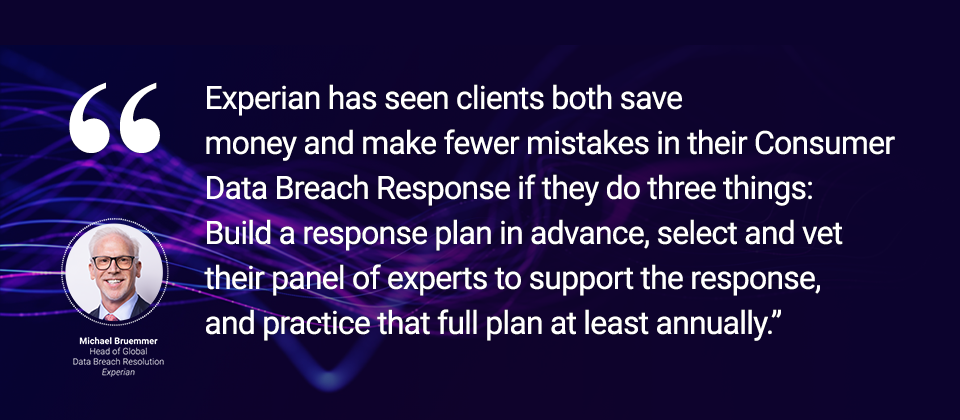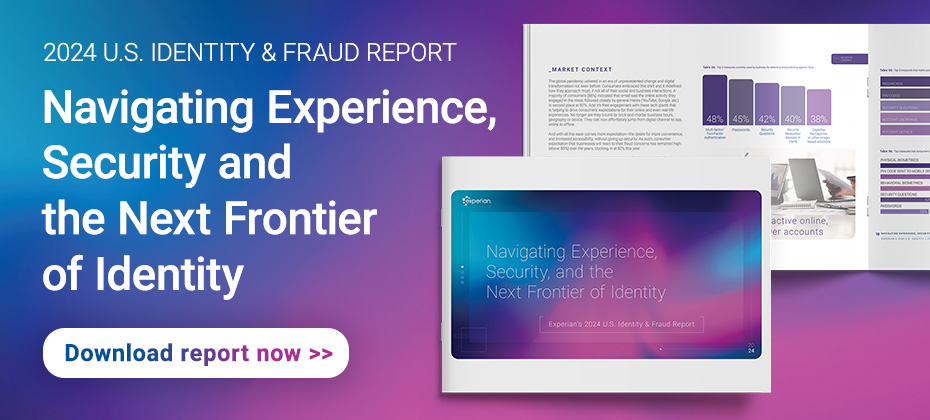All posts by Julie Lee

Despite being a decades-old technology, behavioral analytics is often still misunderstood. We’ve heard from fraud, identity, security, product, and risk professionals that exploring a behavior-based fraud solution brings up big questions, such as: What does behavioral analytics provide that I don’t get now? (Quick answer: a whole new signal and an earlier view of fraud) Why do I need to add even more data to my fraud stack? (Quick answer: it acts with your stack to add insights, not overload) How is this different from biometrics? (Quick answer: while biometrics track characteristics, behavioral analytics tracks distinct actions) These questions make sense — stopping fraud is complex, and, of course, you want to do your research to fully understand what ROI any tool will add. NeuroID, now part of Experian, is one of the only behavioral analytics-first businesses built specifically for stopping fraud. Our internal experts have been crafting behavioral-first solutions to detect everything from simple script fraud bots through to generative AI (genAI) attacks. We know how behavioral analytics works best within your fraud stack, and how to think strategically about using it to stop fraud rings, bot fraud, and other third-party fraud attacks. This primer will provide answers to the biggest questions we hear, so you can make the most informed decisions when exploring how our behavioral analytics solutions could work for you. Q1. What is behavioral analytics and how is it different from behavioral biometrics? A common mistake is to conflate behavioral analytics with behavioral biometrics. But biometrics rely on unique physical characteristics — like fingerprints or facial scans — used for automated recognition, such as unlocking your phone with Face ID. Biometrics connect a person’s data to their identity. But behavioral analytics? They don’t look at an identity. They look at behavior and predict risk. While biometrics track who a person is, behavioral analytics track what they do. For example, NeuroID’s behavioral analytics observes every time someone clicks in a box, edits a field, or hovers over a section. So, when a user’s actions suggest fraudulent intent, they can be directed to additional verification steps or fully denied. And if their actions suggest trustworthiness? They can be fast-tracked. Or, as a customer of ours put it: "Using NeuroID decisioning, we can confidently reject bad actors today who we used to take to step-up. We also have enough information on good applicants sooner, so we can fast-track them and say ‘go ahead and get your loan, we don’t need anything else from you.’ And customers really love that." - Mauro Jacome, Head of Data Science for Addi (read the full Addi case study here). The difference might seem subtle, but it’s important. New laws on biometrics have triggered profound implications for banks, businesses, and fraud prevention strategies. The laws introduce potential legal liabilities, increased compliance costs, and are part of a growing public backlash over privacy concerns. Behavioral signals, because they don’t tie behavior to identity, are often easier to introduce and don’t need the same level of regulatory scrutiny. The bottom line is that our behavioral analytics capabilities are unique from any other part of your fraud stack, full-stop. And it's because we don’t identify users, we identify intentions. Simply by tracking users’ behavior on your digital form, behavioral analytics powered by NeuroID tells you if a user is human or a bot; trustworthy or risky. It looks at each click, edit, keystroke, pause, and other tiny interactions to measure every users’ intention. By combining behavior with device and network intelligence, our solutions provide new visibility into fraudsters hiding behind perfect PII and suspicious devices. The result is reduced fraud costs, fewer API calls, and top-of-the-funnel fraud capture with no tuning or model integration on day one. With behavioral analytics, our customers can detect fraud attacks in minutes, instead of days. Our solutions have proven results of detecting up to 90% of fraud with 99% accuracy (or <1% false positive rate) with less than 3% of your population getting flagged. Q2. What does behavioral analytics provide that I don’t get now? Behavioral analytics provides a net-new signal that you can’t get from any other tools. One of our customers, Josh Eurom, Manager of Fraud for Aspiration Banking, described it this way: “You can quantify some things very easily: if bad domains are coming through you can identify and stop it. But if you see things look odd, yet you can’t set up controls, that’s where NeuroID behavioral analytics come in and captures the unseen fraud.” (read the full Aspiration story here) Adding yet another new technology with big promises may not feel urgent. But with genAI fueling synthetic identity fraud, next-gen fraud bots, and hyper-efficient fraud ring attacks, time is running out to modernize your stack. In addition, many fraud prevention tools today only focus on what PII is submitted — and PII is notoriously easy to fake. Only behavioral analytics looks at how the data is submitted. Behavioral analytics is a crucial signal for detecting even the most modern fraud techniques. Watch our webinar: The Fraud Bot Future-Shock: How to Spot and Stop Next-Gen Attacks Q3. Why do I need to add even more data to my fraud stack? Balancing fraud, friction, and financial impact has led to increasingly complex fraud stacks that often slow conversions and limit visibility. As fraudsters evolve, gaps grow between how quickly you can keep up with their new technology. Fraudsters have no budget constraints, compliance requirements, or approval processes holding them back from implementing new technology to attack your stack, so they have an inherent advantage. Many fraud teams we hear from are looking for ways to optimize their workflows without adding to the data noise, while balancing all the factors that a fraud stack influences beyond overall security (such as false positives and unnecessary friction). Behavioral analytics is a great way to work smarter with what you have. The signals add no friction to the onboarding process, are undetectable to your customers, and live on a pre-submit level, using data that is already captured by your existing application process. Without requiring any new inputs from your users or stepping into messy biometric legal gray areas, behavioral analytics aggregates, sorts, and reviews a broad range of cross-channel, historical, and current customer behaviors to develop clear, real-time portraits of transactional risks. By sitting top-of-funnel, behavioral analytics not only doesn’t add to the data noise, it actually clarifies the data you currently rely on by taking pressure off of your other tools. With these insights, you can make better fraud decisions, faster. Or, as Eurom put it: “Before NeuroID, we were not automatically denying applications. They were getting an IDV check and going into a manual review. But with NeuroID at the top of our funnel, we implemented automatic denial based on the risky signal, saving us additional API calls and reviews. And we’re capturing roughly four times more fraud. Having behavioral data to reinforce our decision-making is a relief.” The behavioral analytics difference Since the world has moved online, we’re missing the body language clues that used to tell us if someone was a fraudster. Behavioral analytics provides the digital body language differentiator. Behavioral cues — such as typing speed, hesitation, and mouse movements — highlight riskiness. The cause of that risk could be bots, stolen information, fraud rings, synthetic identities, or any combination of third-party fraud attack strategies. Behavioral analytics gives you insights to distinguish between genuine applicants and potentially fraudulent ones without disrupting your customer’s journey. By interpreting behavioral patterns at the very top of the onboarding funnel, behavior helps you proactively mitigate fraud, reduce false positives, and streamline onboarding, so you can lock out fraudsters and let in legitimate users. This is all from data you already capture, simply tracking interactions on your site. Stop fraud, faster: 5 simple uses where behavioral analytics shine While how you approach a behavioral analytics integration will vary based on numerous factors, here are some of the immediate, common use cases of behavioral analytics. Detecting fraud bots and fraud rings Behavioral analytics can identify fraud bots by their frameworks, such as Puppeter or Stealth, and through their behavioral patterns, so you can protect against even the most sophisticated fourth-generation bots. NeuroID provides holistic coverage for bot and fraud ring detection — passively and with no customer friction, often eliminating the need for CAPTCHA and reCAPTCHA. With this data alone, you could potentially blacklist suspected fraud bot and fraud ring attacks at the top of the fraud prevention funnel, avoiding extra API calls. Sussing out scams and coercions When users make account changes or transactions under coercion, they often show unfamiliarity with the destination account or shipping address entered. Our real-time assessment detects these risk indicators, including hesitancy, multiple corrections, and slow typing, alerting you in real-time to look closer. Stopping use of compromised cards and stolen IDs Traditional PII methods can fall short against today’s sophisticated synthetic identity fraud. Behavioral analytics uncovers synthetic identities by evaluating how PII is entered, instead of relying on PII itself (which is often corrupted). For example, our behavioral signals can assess users’ familiarity with the billing address they’re entering for a credit card or bank account. Genuine account holders will show strong familiarity, while signs of unfamiliarity are indicators of an account under attack. Detecting money mules Our behavioral analytics solutions track how familiar users are with the addresses they enter, conducting a real-time, sub-millisecond familiarity assessment. Risk markers such as hesitancy, multiple corrections, slow typing speed raise flags for further exploration. Stopping promotion and discount abuse Our behavioral analytics identifies risky versus trustworthy users in promo and discount fields. By assessing behavior, device, and network risk, we help you determine if your promotions attract more risky than trustworthy users, preventing fraudsters from abusing discounts. Learn more about our behavioral analytics solutions. Learn more Watch webinar

With cyber threats intensifying and data breaches rising, understanding how to respond to incidents is more important than ever. In this interview, Michael Bruemmer, Head of Global Data Breach Resolution at Experian, is joined by Matthew Meade, Chair of the Cybersecurity, Data Protection & Privacy Group at Eckert Seamans, to discuss the realities of data breach response. Their session, “Cyber Incident Response: A View from the Trenches,” brings insights from the field and offers a preview of Experian's 2025 Data Breach Industry Forecast, including the role of generative artificial intelligence (AI) in data breaches. From the surge in business email compromises (BEC) to the relentless threat of ransomware, Bruemmer and Meade dive into key issues facing organizations big and small today. Drawing from Experian's experience handling nearly 5,000 breaches this year, Bruemmer sheds light on effective response practices and reveals common pitfalls. Meade, who served as editor-in-chief for the Sedona Conference’s new Model Data Breach Notification Law, explains the implications of these regulatory updates for organizations and highlights how standardized notification practices can improve outcomes. Bruemmer and Meade’s insights offer a proactive guide to tackling tomorrow’s cyber threats, making it a must-listen for anyone aiming to stay one step ahead. Listen to the full interview for a valuable look at both the current landscape and what's next. Click here for more insight into safeguarding your organization from emerging cyber threats.

As online accounts become essential for activities ranging from shopping and social media to banking, "account farming" has emerged as a significant fraud risk. This practice involves creating fake or unauthorized accounts en masse, often for malicious purposes. Understanding how account farming works, why it’s done and how businesses can protect themselves is crucial for maintaining data integrity, safeguarding customer trust and protecting your bottom line. How does account farming work? Account farming is the process of creating and cultivating multiple user accounts, often using fake or stolen identities. These accounts may look like legitimate users, but they’re controlled by a single entity or organization, usually with fraudulent intent. Here’s a breakdown of the typical steps involved in account farming: Identity generation: Account farmers start by obtaining either fake or stolen personal information. They may buy these datasets on the dark web or scrape publicly available information to make each account seem legitimate. Account creation: Using bots or manual processes, fraudsters create numerous accounts on a platform. Often, they’ll employ automated tools to expedite this process, bypassing CAPTCHA or reCAPTCHA systems or using proxy servers to mask their IP addresses and avoid detection. Warm-up phase: After initial creation, account farmers often let the accounts sit for a while, engaging in limited, non-suspicious activity to avoid triggering security alerts. This “warming up” process helps the accounts seem more authentic. Activation for fraudulent activity: Once these accounts reach a level of credibility, they’re activated for the intended purpose. This might include spamming, fraud, phishing, fake reviews or promotional manipulation. Why is account farming done? There are several reasons account farming has become a widespread problem across different industries. Here are some common motivations: Monetary gain: Fraudsters use farmed accounts to commit fraudulent transactions, like applying for loans and credit products, accessing promotional incentives or exploiting referral programs. Spam and phishing: Fake accounts enable widespread spam campaigns or phishing attacks, compromising customer data and damaging brand reputation. Data theft: By creating and controlling multiple accounts, fraudsters may access sensitive data, leading to further exploitation or resale on the dark web. Manipulating metrics and market perception: Some industries use account farming to boost visibility and credibility falsely. For example, on social media, fake accounts can be used to inflate follower counts or engagement metrics. In e-commerce, fraudsters may create fake accounts to leave fake reviews or upvote products, falsely boosting perceived popularity and manipulating purchasing decisions. How does account farming lead to fraud risks? Account farming is a serious problem that can expose businesses and their customers to a variety of risks: Financial loss: Fake accounts created to exploit promotional offers or referral programs can cause victims to experience significant financial losses. Additionally, businesses can incur costs from chargebacks or fraudulent refunds triggered by these accounts. Compromised customer experience: Legitimate customers may suffer from poor experiences, such as spam messages, unsolicited emails or fraudulent interactions. This leads to diminished brand trust, which is costly to regain. Data breaches and compliance risks: Account farming often relies on stolen data, increasing the risk of data breaches. Businesses subject to regulations like GDPR or CCPA may face hefty fines if they fail to protect consumer information adequately. READ MORE: Our Data Breach Industry Forecast predicts what’s in store for the coming year. How can businesses protect themselves from account farming fraud? As account farming tactics evolve, businesses need a proactive and sophisticated approach to detect and prevent these fraudulent activities. Experian’s fraud risk management solutions provide multilayered and customizable solutions to help companies safeguard themselves against account farming and other types of fraud. Here’s how we can help: Identity verification solutions: Experian’s fraud risk and identity verification platform integrates multiple verification methods to confirm the authenticity of user identities. Through real-time data validation, businesses can verify the legitimacy of user information provided at the account creation stage, detecting and blocking fake identities early in the process. Its flexible architecture allows companies to adapt their identity verification process as new fraud patterns emerge, helping them stay one step ahead of account farmers. Behavioral analytics: One effective way to identify account farming is to analyze user behavior for patterns consistent with automated or scripted actions (AKA “bots”). Experian’s behavioral analytics solutions, powered by NeuroID, use advanced machine learning algorithms to identify unusual behavioral trends among accounts. By monitoring how users interact with a platform, we can detect patterns common in farmed accounts, like uniform interactions or repetitive actions that don’t align with human behavior. Device intelligence: To prevent account farming fraud, it’s essential to go beyond user data and examine the devices used to create and access accounts. Experian’s solutions combine device intelligence with identity verification to flag suspicious devices associated with multiple accounts. For example, account farmers often use virtual machines, proxies or emulators to create accounts without revealing their actual location or device details. By identifying and flagging these high-risk devices, we help prevent fraudulent accounts from slipping through the cracks. Velocity checks: Velocity checks are another way to block fraudulent account creation. By monitoring the frequency and speed at which new accounts are created from specific IP addresses or devices, Experian’s fraud prevention solutions can identify spikes indicative of account farming. These velocity checks work in real-time, enabling businesses to act immediately to block suspicious activity and minimize the risk of fake account creation. Continuous monitoring and risk scoring: Even after initial account creation, continuous monitoring of user activity helps to identify accounts that may have initially bypassed detection but later engage in suspicious behavior. Experian’s risk scoring system assigns a fraud risk score to each account based on its behavior over time, alerting businesses to potential threats before they escalate. Final thoughts: Staying ahead of account farming fraud Preventing account farming is about more than just blocking bots — it’s about safeguarding your business and its customers against fraud risk. By understanding the mechanics of account farming and using a multi-layered approach to fraud detection and identity verification, businesses can protect themselves effectively. Ready to take a proactive stance against account farming and other evolving fraud tactics? Explore our comprehensive solutions today. Learn More This article includes content created by an AI language model and is intended to provide general information.

In 2023, mobile fraud attacks surged by over 50%.1 With people relying more on mobile devices for day-to-day activities, like banking, shopping and healthcare, fraudsters have found new ways to exploit mobile security. With phones housing such sensitive data, how can businesses ensure that the person on the other end of a mobile device is who they claim to be? Enter mobile identity verification, a process designed to protect consumers and businesses in today’s mobile-driven world. Understanding mobile identity Mobile identity refers to the digital identity associated with a mobile device. This includes information like phone numbers, SIM cards, device IDs and user credentials that uniquely identify a person or device. Verifying that the mobile identity belongs to the correct individual is crucial for secure digital transactions. What is mobile identity verification? Mobile identity verification confirms the legitimacy of users accessing services via their mobile device. This process uses personal data, biometrics and mobile network information to authenticate identity, ensuring businesses interact with real customers without unnecessary friction. Why is mobile identity verification important? The rise of mobile banking, mobile payments and other mobile-based services has increased the need for robust security measures. Cybercriminals have found ways to exploit the mobile ecosystem through SIM swapping, phishing and other fraud tactics. This makes mobile identity verification critical for businesses looking to protect sensitive customer data and prevent unauthorized access. Here are some of the key reasons why mobile identity verification is essential: Preventing fraud: Identity theft and fraud are major concerns for businesses and consumers alike. Mobile identity verification helps to reduce the risk of fraud by ensuring that the user is who they say they are. Enhancing user trust: Customers are more likely to trust a service that prioritizes their security. Businesses that implement mobile identity verification solutions provide an extra layer of protection, which can help build customer confidence. Regulatory compliance: Many industries, including finance and healthcare, are subject to strict regulations concerning data privacy and security. Mobile identity verification helps businesses meet these regulatory requirements by offering a secure way to verify customer identities. Improving user experience: While security is essential, businesses must also ensure that they do not create a cumbersome user experience. Mobile identity verification solutions offer a quick and seamless way for users to verify their identities without sacrificing security. This is especially important for onboarding new users or completing transactions quickly. How does mobile identity verification work? Mobile identity verification involves a combination of different techniques and technologies, depending on the service provider and the level of security required. Some common methods include: Biometric authentication: Biometrics like fingerprint scans, facial recognition and voice recognition are becoming increasingly popular for verifying identities. These methods are secure and convenient for users since they don't require remembering passwords or PINs. SMS-based verification: One-time passwords (OTPs) sent via SMS to a user's mobile phone are still widely used. This method links the verification process directly to the user's mobile device, ensuring that they have possession of their registered phone number. Device-based verification: By analyzing the unique identifiers of a mobile device, such as IMEI numbers, businesses can confirm that the device is registered to the user attempting to access services. This helps prevent fraud attempts from unregistered or stolen devices. Mobile network data: Mobile network operators have access to valuable information, such as the user’s location, SIM card status and network activity. By leveraging this data, businesses can further verify that the user is legitimate and actively using their mobile network as expected. Behavioral analytics: By analyzing patterns in user behavior — such as typing speed, navigation habits, and interactions with apps — mobile identity verification solutions can detect anomalies that might indicate fraudulent activity. For instance, if a user’s behavior demonstrates low-to-no familiarity with the PII they provide, it can trigger an additional layer of verification to ensure security. The role of identity solutions in mobile identity verification Mobile identity verification is just one part of a broader range of identity solutions that help businesses authenticate users and protect sensitive data. These solutions not only cover mobile devices but extend to other digital touchpoints, ensuring that organizations have a holistic, multilayered approach to identity verification across all channels. Companies that provide comprehensive identity verification solutions can help organizations build robust security infrastructures while offering seamless customer experiences. For instance, Experian offers cutting-edge solutions designed to meet the growing demand for secure and efficient identity verification and authentication. These solutions can significantly reduce fraud and improve customer satisfaction. The growing importance of digital identity In the digital age, managing and verifying identities extends beyond traditional physical credentials like driver’s licenses or social security numbers. Digital identity plays an essential role in enabling secure online transactions, personalizing user experiences and protecting individuals' privacy. However, with great convenience comes great responsibility. Businesses need to strike a balance between security and personalization to ensure they protect user data while still offering a smooth customer experience. As mobile identity verification becomes more widespread, it’s clear that safeguarding digital identity is more important than ever. To learn more about the importance of digital identity and how businesses can find the right balance between security and personalization, check out this article: Digital identity: finding the balance between personalization and security. How Experian can help Experian is at the forefront of providing innovative identity verification solutions that empower businesses to protect their customers and prevent fraud. With solutions tailored for mobile identity verification, businesses can seamlessly authenticate users while minimizing friction. Experian’s technology integrates behavioral analytics, device intelligence and mobile network data to create a comprehensive and secure identity verification process. Whether you’re looking for a complete identity verification solution or need specialized mobile identity verification services, Experian’s identity verification and authentication solutions offer the solutions and expertise your organization needs to stay secure in the evolving digital landscape. Learn More 1 Kapersky This article includes content created by an AI language model and is intended to provide general information.

In this article...What is reject inference? How can reject inference enhance underwriting? Techniques in reject inference Enhancing reject inference design for better classification How Experian can assist with reject inference In the lending world, making precise underwriting decisions is key to minimizing risks and optimizing returns. One valuable yet often overlooked technique that can significantly enhance your credit underwriting process is reject inferencing. This blog post offers insights into what reject inference is, how it can improve underwriting, and various reject inference methods. What is reject inference? Reject inference is a statistical method used to predict the potential performance of applicants who were rejected for a loan or credit — or approved but did not book. In essence, it helps lenders and financial institutions gauge how rejected or non-booked applicants might have performed had they been accepted or booked. By incorporating reject inference, you gain a more comprehensive view of the applicant pool, which leads to more informed underwriting decisions. Utilizing reject inference helps reduce biases in your models, as decisions are based on a complete set of data, including those who were initially rejected. This technique is crucial for refining credit risk models, leading to more accurate predictions and improved financial outcomes. How can reject inference enhance underwriting? Incorporating reject inference into your underwriting process offers several advantages: Identifying high-potential customers: By understanding the potential behavior of rejected applicants, you can uncover high-potential customers who might have been overlooked before. Improved risk assessment: Considering the full spectrum of applicants provides a clearer picture of the overall risk landscape, allowing for more informed lending decisions. This can help reduce default rates and enhance portfolio performance. Optimizing credit decisioning models: Including inferred data from rejected and non-booked applicants makes your credit scoring models more representative of the entire applicant population. This results in more robust and reliable predictions. Techniques in reject inference Several techniques are employed in reject inference, each with unique strengths and applications. Understanding these techniques is crucial for effectively implementing reject inference in your underwriting process. Let's discuss three commonly used techniques: Parceling: This technique involves segmenting rejected applicants based on their characteristics and behaviors, creating a more detailed view of the applicant pool for more precise predictions. Augmentation: This method adds inferred data to the dataset of approved applicants, producing a more comprehensive model that includes both approved and inferred rejected applicants, leading to better predictions. Reweighting: This technique adjusts the weights of approved applicants to reflect the characteristics of rejected applicants, minimizing bias towards the approved applicants and improving prediction accuracy. Pre-diction method The pre-diction method is a common approach in reject inference that uses data collected at the time of application to predict the performance of rejected applicants. The advantage of this method is its reliance on real-time data, making it highly relevant and current. For example, pre-diction data can include credit bureau attributes from the time of application. This method helps develop a model that predicts the outcomes of rejected applicants based on performance data from approved applicants. However, it may not capture long-term trends and could be less effective for applicants with unique characteristics. Post-diction method The post-diction method uses data collected after the performance window to predict the performance of rejected applicants. Leveraging historical data, this method is ideal for capturing long-term trends and behaviors. Post-diction data may include credit bureau attributes from the end of the performance window. This method helps develop a model based on historical performance data, which is beneficial for applicants with unique characteristics and can lead to higher performance metrics. However, it may be less timely and require more complex data processing compared to pre-diction. Enhancing reject inference design for better classification To optimize your reject inference design, focus on creating a model that accurately classifies the performance of rejected and non-booked applicants. Utilize a combination of pre-diction and post-diction data to capture both real-time and historical trends. Start by developing a parceling model using pre-diction data, such as credit bureau attributes from the time of application, to predict rejected applicants' outcomes. Regularly update your model with the latest data to maintain its relevance. Next, incorporate post-diction data, including attributes from the end of the performance window, to capture long-term trends. Combining both data types will result in a more comprehensive model. Consider leveraging advanced analytics techniques like machine learning and artificial intelligence to refine your model further, identifying hidden patterns and relationships for more accurate predictions. How Experian can assist with reject inference Reject inference is a powerful tool for enhancing your underwriting process. By predicting the potential performance of rejected and non-booked applicants, you can make more inclusive and accurate decisions, leading to improved risk assessment and optimized credit scoring models. Experian offers various services and solutions to help financial institutions and lenders effectively implement reject inference into their decisioning strategy. Our solutions include comprehensive and high-quality datasets, which empower you to build models that are more representative of the entire applicant population. Additionally, our advanced analytics tools simplify data analysis and model development, enabling you to implement reject inference efficiently without extensive technical expertise. Ready to elevate your underwriting process? Contact us today to learn more about our suite of advanced analytics solutions or hear what our experts have to say in this webinar. Watch Webinar Learn More This article includes content created by an AI language model and is intended to provide general information.

Experian’s ninth annual report on identity and fraud highlights persistent worries among consumers and businesses about fraud, including growing threats from GenAI. In this report, we explore how the evolving fraud landscape is impacting identity verification, customer experience, and business priorities for the future. Our 2024 U.S. Identity and Fraud Report draws insights from surveys of over 2,000 U.S. consumers and 200 businesses. This year’s report dives into: Evolving consumer sentiment over security and experience Businesses’ investments to tackle growing fraud challenges Effective technology solutions to accurately identify and authenticate consumers The impact of GenAI on the fraud landscape To keep pace with the evolving landscape, businesses will need to apply a multi-faceted strategy that leverages multiple types of recognition and security to stop all types of fraud while allowing real customers through. To learn more about our findings and perspective, read the full 2024 U.S. Identity and Fraud Report, watch our on-demand webinar, or read the press release. Download Now Watch Webinar Read Press Release

In this article...Rise of AI in fraudulent activitiesFighting AI with AI Addressing fraud threatsBenefits of leveraging AI fraud detectionFinancial services use caseExperian's AI fraud detection solutions In a world where technology evolves at lightning speed, fraudsters are becoming more sophisticated in their methods, leveraging advancements in artificial intelligence (AI). According to our 2025 U.S. Identity and Fraud Report, 72% of businesses expect AI fraud to be among their top challenges by 2026. To combat emerging fraud threats, organizations are turning to AI fraud detection to stay ahead and protect their businesses and their customers, essentially fighting AI with AI. This blog post explores the evolving AI fraud and AI fraud detection landscape. The rise of AI in fraudulent activities Technology is a double-edged sword. While it brings numerous advancements, it also provides fraudsters with new tools to exploit. AI is no exception. Here are some ways fraudsters are utilizing AI: Automated bot attacks: Fraudsters employ AI to design automated scripts that launch large-scale attacks on systems. These scripts can perform credential stuffing, where stolen usernames and passwords are automatically tested across multiple sites to gain unauthorized access. Deepfakes and synthetic identities: Deepfake technology and the creation of synthetic identities are becoming more prevalent. Fraudsters use AI to manipulate videos and audio, making it possible to impersonate individuals convincingly. Similarly, synthetic identities blend real and fake information to create false personas. Phishing and social engineering: AI-driven phishing attacks are more personalized and convincing than traditional methods. By analyzing social media profiles and other online data, fraudsters craft tailored messages that trick individuals into revealing sensitive information. Watch now: Our 2025 Fraud Trends webinar explores how businesses can navigate rising risk, meet growing consumer expectations, and stay ahead of increasingly complex attacks. Fighting AI with AI in fraud detection To combat these sophisticated threats, businesses must adopt equally advanced measures. AI fraud detection offers a robust solution: Machine learning algorithms: Fraud detection machine learning algorithms analyze vast datasets to identify patterns and anomalies that indicate fraudulent behavior. These algorithms can continuously learn and adapt, improving their accuracy over time. Real-time monitoring: AI systems provide real-time monitoring of transactions and activities. This allows businesses to detect and respond to fraud attempts instantly, minimizing potential damage. Predictive analytics: Predictive analytics uses historical data to forecast future fraud trends. By anticipating potential threats, organizations can take proactive measures to safeguard their assets. Addressing fraud threats with AI fraud detection AI's versatility allows it to tackle various types of fraud effectively: Identity theft: According to our research, 68% of consumers rank identity theft as their top online concern. AI systems can help safeguard consumers by cross-referencing multiple data points to verify identities. They can spot inconsistencies that indicate identity theft, such as mismatched addresses or unusual login locations. Payment fraud: Coming in second to identity theft, 61% of consumers rank stolen credit card information as their top online concern. Payment fraud includes unauthorized credit card transactions and chargebacks. AI can be used in payment fraud detection to surface unusual spending patterns and flag suspicious transactions for further investigation. Account takeover: Account takeover fraud, one of the top-most encountered fraud events reported by U.S. businesses, occurs when fraudsters gain access to user accounts and conduct unauthorized activities.* AI identifies unusual login behaviors and implements additional security measures to prevent account breaches. Synthetic identity fraud: Synthetic identity fraud involves the creation of fake identities using real and fabricated information. AI fraud solutions detect these false identities by analyzing data inconsistencies and behavioral patterns. Benefits of leveraging AI fraud detection Implementing AI fraud detection offers numerous advantages: Enhanced accuracy: AI systems are highly accurate in identifying fraudulent activities. Their ability to analyze large datasets and detect subtle anomalies surpasses traditional methods. Cost savings: By preventing fraud losses, AI systems save businesses significant amounts of money. They also reduce the need for manual investigations, freeing up resources for other tasks. Improved customer experience: AI fraud detection minimizes false positives, ensuring genuine customers face minimal friction. This enhances the overall customer experience and builds trust in the organization. Scalability: AI systems can handle large volumes of data, making them suitable for organizations of all sizes. Whether you're a small business or a large enterprise, AI can scale to meet your needs. Financial services use case The financial sector is particularly vulnerable to fraud, making AI an invaluable tool for fraud detection in banking. Protecting transactions: Banks use AI to monitor transactions for signs of fraud. Machine learning algorithms analyze transaction data in real time, flagging suspicious activities for further review. Enhancing security: AI enhances security by implementing multifactor authentication and behavioral analytics. These measures make it more challenging for fraudsters to gain unauthorized access. Reducing fraud losses: By detecting and preventing fraudulent activities, AI helps banks reduce their fraud losses throughout the customer lifecycle. This not only saves money but also protects the institution's reputation. Experian's AI fraud detection solutions AI fraud detection is revolutionizing the way organizations combat fraud. Its ability to analyze vast amounts of data, detect anomalies, and adapt to new threats makes it an essential element of any comprehensive fraud strategy. Experian’s range of AI fraud detection solutions help organizations enhance their security measures, reduce fraud losses, authenticate identity with confidence, and improve the overall customer experience. If you're interested in learning more about how AI can protect your business, explore our fraud management solutions or contact us today. Learn More * Source: 2025 U.S. Identity and Fraud Report This article includes content created by an AI language model and is intended to provide general information.

In this article...Recent trends in credit card debtThe rising tide of delinquenciesWhat is credit limit optimization?Benefits of credit limit optimizationEconomic indicators and CLO ImpactEnhanced profitability and risk mitigation This post was originally published on our Global Insights Blog. As credit card issuers grow, the size of their customer base expands, bringing both opportunities and challenges. One of the most critical challenges is managing growth while controlling default rates. Credit limit optimization (CLO) has emerged as a vital tool for banks and credit lenders to achieve this balance. By leveraging machine learning models and mathematical optimization, CLO enables lenders to tailor credit limits to individual customers, enhancing profitability while mitigating risk. Recent trends in credit card debt To understand the significance of CLO, it is essential to consider the current economic landscape. The first quarter of 2024 saw total household debt in the U.S. rise by $184 billion, reaching $17.69 trillion. While credit card balances declined slightly (a reflection of seasonal factors and consumer spending patterns), they remain a substantial component of household liabilities, with total credit card debt standing at approximately $1.26 trillion in early 2024. On average, American households hold around $10,479 in credit card debt, which is down from previous years but still significant. The average APR for credit cards in the first quarter of 2024 was 21.59%.* The rising tide of delinquencies In the first quarter of 2024, about 8.9% (annualized) of credit card balances transitioned into delinquency. This trend underscores the need for credit card issuers to adopt more sophisticated methods to assess credit risk and adjust credit limits accordingly. The rising rate of credit card delinquencies is a key driver behind the adoption of CLO strategies. What is credit limit optimization? Credit limit optimization uses advanced analytics to assess individual customers’ creditworthiness. By analyzing various data points, including payment history, income levels, spending patterns, and economic indicators, these tools can recommend optimal credit limits that maximize customer spending potential while minimizing the risk of default, all within the constraints set by the business in terms of its appetite for risk and capacity. For instance, a customer with a strong payment history and stable income might receive a higher credit limit, encouraging more spending and enhancing the lender’s revenue through interest and interchange fees. Conversely, customers showing signs of financial stress might see their credit limit reduced to prevent them from accumulating unmanageable debt. Benefits of credit limit optimization Improved profitability – By setting credit limits reflecting customers’ credit risk and spending potential, lenders can increase their revenue through higher interest and fee income. Reduced default rates – Lenders can significantly reduce the incidence of bad debt by identifying customers at risk of default and adjusting their credit limits accordingly. Improved customer satisfaction – Personalized credit limits can improve customer satisfaction, as customers are more likely to receive credit that matches their needs and financial situation. Regulatory compliance – CLO can help lenders comply with regulatory requirements by ensuring that credit limits are set based on objective, data-driven criteria. Economic indicators and CLO Impact Several economic indicators provide context for the importance of CLO in the current market. For instance, the Federal Reserve reported that in 2023, fewer than half of adult credit cardholders carried a balance on their cards, down from previous years. This indicates a more cautious approach to credit use among consumers, likely influenced by economic uncertainty and rising interest rates. Moreover, the disparity in credit card debt across different states highlights the varying economic conditions and the need for tailored credit strategies. States like New Jersey have some of the highest average credit card debts, while states like Mississippi have the lowest. This regional variation underscores lenders’ need to adopt flexible, data-driven approaches to credit limit setting. Enhanced profitability and risk mitigation Credit limit optimization is critical for credit card issuers aiming to balance growth and risk management. As economic conditions evolve and consumer behaviors shift, the ability to set personalized credit limits will become increasingly important. By leveraging advanced analytics and machine learning, CLO enhances profitability and contributes to a more stable and resilient financial system. One such solution is Experian’s Ascend Intelligence Services™ Limit, which provides an optimized strategy designed to enhance the precision and effectiveness of credit limit assignments. Ascend Intelligence Services™ Limit combines best-in-class bureau data with machine learning to simulate the impact of different credit limits in real time. This capability allows lenders to quickly test and refine their credit limit strategies without the lengthy trial-and-error period traditionally required. Ascend Intelligence Services Limit enables lenders to set credit limits that align with their business objectives and risk tolerance. By providing insights into the likelihood of default and potential revenue for each credit limit scenario, Ascend Intelligence Services Limit helps design optimal limit strategies. This not only maximizes revenue but also minimizes the risk of defaults by ensuring credit limits are appropriate for each customer’s financial situation. In a landscape marked by rising delinquencies and varying regional debt levels, the strategic use of CLO like Ascend Intelligence Services Limit represents a forward-thinking approach to credit management, benefiting both lenders and consumers. Learn More * HOUSEHOLD DEBT AND CREDIT REPORT (Q1 2024) – Federal Reserve Bank of New York

In this article...What is credit card fraud?Types of credit card fraudWhat is credit card fraud prevention and detection?How Experian® can help with card fraud prevention and detection With debit and credit card transactions becoming more prevalent than cash payments in today’s digital-first world, card fraud has become a significant concern for organizations. Widespread usage has created ample opportunities for cybercriminals to engage in credit card fraud. As a result, millions of Americans fall victim to credit card fraud annually, with 52 million cases reported last year alone.1 Preventing and detecting credit card fraud can save organizations from costly losses and protect their customers and reputations. This article provides an overview of credit card fraud detection, focusing on the current trends, types of fraud, and detection and prevention solutions. What is credit card fraud? Credit card fraud involves the unauthorized use of a credit card to obtain goods, services or funds. It's a crime that affects individuals and businesses alike, leading to financial losses and compromised personal information. Understanding the various forms of credit card fraud is essential for developing effective prevention strategies. Types of credit card fraud Understanding the different types of credit card fraud can help in developing targeted prevention strategies. Common types of credit card fraud include: Card not present fraud occurs when the physical card is not present during the transaction, commonly seen in online or over-the-phone purchases. In 2023, card not present fraud was estimated to account for $9.49 billion in losses.2 Account takeover fraud involves fraudsters gaining access to a victim's account to make unauthorized transactions. In 2023, account takeover attacks increased 354% year-over-year, resulting in almost $13 billion in losses.3,4 Card skimming, which is estimated to cost consumers and financial institutions over $1 billion per year, occurs when fraudsters use devices to capture card information from ATMs or point-of-sale terminals.5 Phishing scams trick victims into providing their card information through fake emails, texts or websites. What is credit card fraud prevention and detection? To combat the rise in credit card fraud effectively, organizations must implement credit card fraud prevention strategies that involve a combination of solutions and technologies designed to identify and stop fraudulent activities. Effective fraud prevention solutions can help businesses minimize losses and protect their customers' information. Common credit card fraud prevention and detection methods include: Fraud monitoring systems: Banks and financial institutions employ sophisticated algorithms and artificial intelligence to monitor transactions in real time. These systems analyze spending patterns, locations, transaction amounts, and other variables to detect suspicious activity. EMV chip technology: EMV (Europay, Mastercard, and Visa) chip cards contain embedded microchips that generate unique transaction codes for each purchase. This makes it more difficult for fraudsters to create counterfeit cards. Tokenization: Tokenization replaces sensitive card information with a unique identifier or token. This token can be used for transactions without exposing actual card details, reducing the risk of fraud if data is intercepted. Multifactor authentication (MFA): Adding an extra layer of security beyond the card number and PIN, MFA requires additional verification such as a one-time code sent to a mobile device, knowledge-based authentication or biometric/document confirmation. Transaction alerts: Many banks offer alerts via SMS or email for every credit card transaction. This allows cardholders to spot unauthorized transactions quickly and report them to their bank. Card verification value (CVV): CVV codes, typically three-digit numbers printed on the back of cards (four digits for American Express), are used to verify that the person making an online or telephone purchase physically possesses the card. Machine learning and AI: Advanced algorithms can analyze large datasets to detect unusual patterns that may indicate fraud, such as sudden large transactions or purchases made in different geographic locations within a short time frame. Advanced algorithms can analyze large datasets to detect unusual patterns that may indicate fraud, such as sudden large transactions or purchases made in different geographic locations within a short time frame. Behavioral analytics: Monitoring user behavior to detect anomalies that may indicate fraud. Education and awareness: Educating consumers about phishing scams, identity theft, and safe online shopping practices can help reduce the likelihood of falling victim to credit card fraud. Fraud investigation units: Financial institutions have teams dedicated to investigating suspicious transactions reported by customers. These units work to confirm fraud, mitigate losses, and prevent future incidents. How Experian® can help with card fraud prevention and detection Credit card fraud detection is essential for protecting businesses and customers. By implementing advanced detection technologies, businesses can create a robust defense against fraudsters. Experian® offers advanced fraud management solutions that leverage identity protection, machine learning, and advanced analytics. Partnering with Experian can provide your business with: Comprehensive fraud management solutions: Experian’s fraud management solutions provide a robust suite of tools to prevent, detect and manage fraud risk and identity verification effectively. Account takeover prevention: Experian uses sophisticated analytics and enhanced decision-making capabilities to help businesses drive successful transactions by monitoring identity and flagging unusual activities. Identifying card not present fraud: Experian offers tools specifically designed to detect and prevent card not present fraud, ensuring secure online transactions. Take your fraud prevention strategies to the next level with Experian's comprehensive solutions. Explore more about how Experian can help. Learn More Sources 1 https://www.security.org/digital-safety/credit-card-fraud-report/ 2 https://www.emarketer.com/chart/258923/us-total-card-not-present-cnp-fraud-loss-2019-2024-billions-change-of-total-card-payment-fraud-loss 3 https://pages.sift.com/rs/526-PCC-974/images/Sift-2023-Q3-Index-Report_ATO.pdf 4 https://www.aarp.org/money/scams-fraud/info-2024/identity-fraud-report.html 5 https://www.fbi.gov/how-we-can-help-you/scams-and-safety/common-scams-and-crimes/skimming This article includes content created by an AI language model and is intended to provide general information.

In this article...What is fair lending?Understanding machine learning modelsThe pitfalls: bias and fairness in ML modelsFairness metricsRegulatory frameworks and complianceHow Experian® can help As the financial sector continues to embrace technological innovations, machine learning models are becoming indispensable tools for credit decisioning. These models offer enhanced efficiency and predictive power, but they also introduce new challenges. These challenges particularly concern fairness and bias, as complex machine learning models can be difficult to explain. Understanding how to ensure fair lending practices while leveraging machine learning models is crucial for organizations committed to ethical and compliant operations. What is fair lending? Fair lending is a cornerstone of ethical financial practices, prohibiting discrimination based on race, color, national origin, religion, sex, familial status, age, disability, or public assistance status during the lending process. This principle is enshrined in regulations such as the Equal Credit Opportunity Act (ECOA) and the Fair Housing Act (FHA). Overall, fair lending is essential for promoting economic opportunity, preventing discrimination, and fostering financial inclusion. Key components of fair lending include: Equal treatment: Lenders must treat all applicants fairly and consistently throughout the lending process, regardless of their personal characteristics. This means evaluating applicants based on their creditworthiness and financial qualifications rather than discriminatory factors. Non-discrimination: Lenders are prohibited from discriminating against individuals or businesses on the basis of race, color, religion, national origin, sex, marital status, age, or other protected characteristics. Discriminatory practices include redlining (denying credit to applicants based on their location) and steering (channeling applicants into less favorable loan products based on discriminatory factors). Fair credit practices: Lenders must adhere to fair and transparent credit practices, such as providing clear information about loan terms and conditions, offering reasonable interest rates, and ensuring that borrowers have the ability to repay their loans. Compliance: Financial institutions are required to comply with fair lending laws and regulations, which are enforced by government agencies such as the Consumer Financial Protection Bureau (CFPB) in the United States. Compliance efforts include conducting fair lending risk assessments, monitoring lending practices for potential discrimination, and implementing policies and procedures to prevent unfair treatment. Model governance: Financial institutions should establish robust governance frameworks to oversee the development, implementation and monitoring of lending models and algorithms. This includes ensuring that models are fair, transparent, and free from biases that could lead to discriminatory outcomes. Data integrity and privacy: Lenders must ensure the accuracy, completeness, and integrity of the data used in lending decisions, including traditional credit and alternative credit data. They should also uphold borrowers’ privacy rights and adhere to data protection regulations when collecting, storing, and using personal information. Understanding machine learning models and their application in lending Machine learning in lending has revolutionized how financial institutions assess creditworthiness and manage risk. By analyzing vast amounts of data, machine learning models can identify patterns and trends that traditional methods might overlook, thereby enabling more accurate and efficient lending decisions. However, with these advancements come new challenges, particularly in the realms of model risk management and financial regulatory compliance. The complexity of machine learning models requires rigorous evaluation to ensure fair lending. Let’s explore why. The pitfalls: bias and fairness in machine learning lending models Despite their advantages, machine learning models can inadvertently introduce or perpetuate biases, especially when trained on historical data that reflects past prejudices. One of the primary concerns with machine learning models is their potential lack of transparency, often referred to as the "black box" problem. Model explainability aims to address this by providing clear and understandable explanations of how models make decisions. This transparency is crucial for building trust with consumers and regulators and for ensuring that lending practices are fair and non-discriminatory. Fairness metrics Key metrics used to evaluate fairness in models can include standardized mean difference (SMD), information value (IV), and disparate impact (DI). Each of these metrics offers insights into potential biases but also has limitations. Standardized mean difference (SMD). SMD quantifies the difference between two groups' score averages, divided by the pooled standard deviation. However, this metric may not fully capture the nuances of fairness when used in isolation. Information value (IV). IV compares distributions between control and protected groups across score bins. While useful, IV can sometimes mask deeper biases present in the data. Disparate impact (DI). DI, or the adverse impact ratio (AIR), measures the ratio of approval rates between protected and control classes. Although DI is widely used, it can oversimplify the complex interplay of factors influencing credit decisions. Regulatory frameworks and compliance in fair lending Ensuring compliance with fair lending regulations involves more than just implementing fairness metrics. It requires a comprehensive end-to-end approach, including regular audits, transparent reporting, and continuous monitoring and governance of machine learning models. Financial institutions must be vigilant in aligning their practices with regulatory standards to avoid legal repercussions and maintain ethical standards. Read more: Journey of a machine learning model How Experian® can help By remaining committed to regulatory compliance and fair lending practices, organizations can balance technological advancements with ethical responsibility. Partnering with Experian gives organizations a unique advantage in the rapidly evolving landscape of AI and machine learning in lending. As an industry leader, Experian offers state-of-the-art analytics and machine learning solutions that are designed to drive efficiency and accuracy in lending decisions while ensuring compliance with regulatory standards. Our expertise in model risk management and machine learning model governance empowers lenders to deploy robust and transparent models, mitigating potential biases and aligning with fair lending practices. When it comes to machine learning model explainability, Experian’s clear and proven methodology assesses the relative contribution and level of influence of each variable to the overall score — enabling organizations to demonstrate transparency and fair treatment to auditors, regulators, and customers. Interested in learning more about ensuring fair lending practices in your machine learning models? Learn More This article includes content created by an AI language model and is intended to provide general information.

Experian’s award-winning platform now brings together market-leading data, generative AI and cutting-edge machine learning solutions for analytics, credit decisioning and fraud into a single interface — simplifying the deployment of analytical models and enabling businesses to optimize their practices. The platform updates represent a notable milestone, fueled by Experian’s significant investments in innovation over the last eight years as part of its modern cloud transformation. “The evolution of our platform reaffirms our commitment to drive innovation and empower businesses to thrive. Its capabilities are unmatched and represent a significant leap forward in lending technology, democratizing access to data in compliant ways while enabling lenders of all sizes to seamlessly validate their customers’ identities with confidence, help expand fair access to credit and offer awesome user and customer experiences,” said Alex Lintner CEO Experian Software Solutions. The enhanced Experian Ascend Platform dramatically reduces time to install and offers streamlined access to many of Experian's award-winning integrated solutions and tools through a single sign-on and a user-friendly dashboard. Leveraging generative AI, the platform makes it easy for organizations of varying sizes and experience levels to pivot between applications, automate processes, modernize operations and drive efficiency. In addition, existing clients can easily add new capabilities through the platform to enhance business outcomes. Read Press Release Learn More Check out Experian Ascend Platform in the media: Transforming Software for Credit, Fraud and Analytics with Experian Ascend Platform™ (Episode 160) Reshaping the Future of Financial Services with Experian Ascend Platform Introducing Experian’s Cloud-based Ascend Technology Platform with GenAI Integration 7 enhancements of Experian Ascend Platform

With e-commerce booming and more transactions occurring online, the threat of chargeback fraud has never been more significant. In this article, we'll explore chargeback fraud, why it's a growing problem, and, most importantly, how to prevent it. Whether you're a small or large business, understanding and implementing robust chargeback fraud prevention measures is critical to protecting your organization. What is chargeback fraud? Before we can prevent chargeback fraud, we need to know what we're dealing with. A chargeback happens when a cardholder disputes a transaction, or files a chargeback request, leading to the reversal of the payment to the merchant. Chargebacks can occur for various reasons including: Fraudulent transactions: If a card is stolen or its information is used without authorization, like in the case of account takeover fraud or card not present fraud, the cardholder can dispute the charges. Unauthorized transactions: Even if the cardholder didn't lose their card, they might notice charges they didn't make. Quality issues: If the product or service doesn't meet the cardholder's expectations or has a defect, they might dispute the charge. Billing errors: Sometimes, billing mistakes happen, such as being charged multiple times for the same transaction. Subscription cancellations: When a cardholder cancels a subscription but continues to be billed they can dispute the charges. While there are legitimate reasons for chargebacks, chargeback fraud, also known as friendly fraud, occurs when a customer makes a legitimate purchase with their credit card and then disputes the charge by filing a chargeback request. Unlike third-party fraud, where the cardholder's information is stolen or used without permission, in chargeback fraud, the cardholder initiates the dispute to avoid paying for goods or services they legitimately received. Chargeback fraud can take various forms: False claims of non-receipt: The cardholder claims they never received the purchased item, even though they did. Unauthorized transaction claims: The cardholder denies making the purchase, even though they did so legitimately. Product/service dissatisfaction: The cardholder claims dissatisfaction with the product or service as a reason for disputing the charge, even if the product or service was as described. Subscription services: The cardholder signs up for a subscription service and then disputes the recurring charges as unauthorized or unwanted. Why chargeback fraud is on the rise Chargeback fraud is becoming more pervasive for a couple of reasons. First, as e-commerce grows, so does the opportunity for fraud. Without face-to-face interactions, fraudsters can pull off their schemes more easily. Second, the process of issuing chargebacks has become consumer-friendly, with banks often siding with the cardholder without deep scrutiny of the claim. Finally, with the rise of subscription-based services and digital goods, the incidence of "friendly fraud" is increasing. The impact and repercussions of chargeback fraud The impact of chargeback fraud can be felt across several areas within a business. Financially, it's a clear and direct loss. There are also significant operational costs associated with managing chargebacks, including potential product loss, bank and related fees, and administrative work. However, the less tangible, more insidious repercussions involve damage to the business's reputation. A high chargeback rate can lead to a merchant account being suspended or terminated, causing a loss of the ability to process credit card payments. A tarnished reputation can further lead to losing consumer trust, which can be hard to regain. Preventing chargeback fraud Preventing and managing chargeback fraud often involves implementing fraud prevention solutions, providing clear communication and customer support, and disputing illegitimate chargebacks with evidence when possible. Here are key actions you can take to protect your business against chargeback fraud: Educate and communicate with customers: Ensure your customers are fully aware of your return and refund policies. Be clear and transparent in your communications about what happens in the event of a disputed transaction. This can significantly reduce misunderstandings that often lead to legitimate chargebacks. Implement stringent transaction verification processes: Utilize Address Verification Services (AVS) and Card Verification Value (CVV2) verification for online and over-the-phone transactions. These credit card authentication services add an extra layer of security and can establish the validity of a purchase. Keep meticulous records: Document all transactions, including emails, phone calls, and any other purchase-related correspondence. In the event of a dispute, these records can serve as compelling evidence to defend the transaction. Immediate shipment and tracking: Ship products as quickly as possible after purchase and provide tracking information to customers. This delights customers and provides tangible proof of delivery should a chargeback be disputed. Utilize advanced fraud detection tools: Many fraud detection services are available that can instantly flag potentially fraudulent transactions, from monitoring for suspicious spending patterns to IP tracking for online orders. Examples include: Tokenization: Tokenization replaces sensitive card data with a "token," a random string of characters that is useless to fraudsters. This token can be stored or transmitted easily, with the actual payment information securely kept off-site. Machine learning and AI: Machine learning and AI fraud detection solutions can analyze vast amounts of transaction data to detect patterns and anomalies, thus flagging potentially fraudulent activity in real-time. The role of customer support in chargeback prevention While the above tools can help your organization prevent fraudulent charge backs, you likely already have a key tool in your company that can help mitigate chargebacks altogether. Your customer support team is your front line in chargeback prevention. Train them to handle customer inquiries effectively and resolve issues before they escalate. Offer multiple contact channels: Give customers several ways to reach your support team, such as email, phone, and live chat. The more easily they can contact you, the less likely they are to resort to a chargeback. Ensure prompt and courteous service: A positive and responsive customer service experience can turn a potential chargeback into a loyalty-building opportunity. Make refunds and returns as easy as possible for your customers. Additionally, clear and generous policies will reduce dissatisfaction and the likelihood of chargebacks. How we can help Chargeback fraud can be a daunting prospect for any business, but with the right strategies in place, you can protect your business, your customers and your bottom line. Our fraud management solutions provide robust verification options and layered risk management to help reduce the risk of chargeback fraud. Our advanced fraud detection solutions leverage machine learning algorithms and behavioral analytics to confirm the identity of customers during transactions, identify suspicious patterns and activities, and offer deeper insights that enhance fraud prevention strategies. These solutions can help detect potential instances of chargeback fraud in real-time or during post-transaction analysis. Learn more

In a financial world that's increasingly connected and complex, monitoring transactions is not just good business practice — it's a regulatory necessity. Anti-money laundering (AML) transaction monitoring stands as a crucial barrier against financial crimes, which ensures the integrity of financial systems worldwide. For financial institutions, the challenges of AML compliance and the tools to meet them continue to evolve. In this blog post, we'll walk through the basics, best practices, and future of AML transaction monitoring. What is AML transaction monitoring? AML transaction monitoring refers to the systems and processes financial institutions use to detect and report potentially suspicious transactions to the Financial Crimes Enforcement Network (FinCEN) under the United States Department of Treasury, which spearheads the efforts to track financial crimes — money laundering and financing of criminal or terrorist activities. By continuously monitoring customer transactions and establishing patterns of behavior, suspicious activities can be identified for further investigation. The role of AML transaction monitoring AML transaction monitoring identifies potential criminal activities and helps maintain a clean and efficient financial ecosystem. By being proactive in preventing the misuse of services, organizations can protect their reputation, strengthen customer trust, and uphold regulatory requirements. The challenge of false positives However, AML compliance is not without challenges. The systems in place often produce many 'false positives', transactions identified as potentially suspicious that, after investigation, turn out to be mundane. These false alarms can overwhelm compliance departments, leading to inefficiency and potentially missing real red flags. Why is AML transaction monitoring important? Understanding the importance of AML transaction monitoring requires a broader look at the implications of financial crimes. Money laundering often supports other serious crimes such as drug trafficking, fraud, and even terrorism. The ability to interrupt the flow of illicit funds also disrupts these additional criminal networks. Furthermore, for organizations, the cost of non-compliance can be substantial — financially and reputationally. Penalties for inadequate AML controls can be hefty, signaling the need for robust monitoring systems. Specifics on compliance Compliance with AML regulations is not a choice but a must. Financial institutions are required to comply with AML laws and regulations to protect their businesses and the industry as a whole. This includes understanding and adhering to regulation changes, which can be complex and have significant operational impacts. How does AML transaction monitoring work? There are two main approaches to transaction monitoring: Rule-based systems: These rely on pre-defined rules that flag transactions exceeding certain thresholds, originating from high-risk countries, or involving specific types of activities. Scenario-based systems: These use more sophisticated algorithms to analyze transaction patterns and identify anomalies that might not be captured by simple rules. This can include analyzing customer behavior, source of funds, and the purpose of transactions. Most organizations use a combination of both approaches. Transaction monitoring software is a valuable tool, but it's important to remember that it's not a foolproof solution. Human analysis is still essential to investigate flagged transactions and determine if they are truly suspicious. Implementing AML transaction monitoring solutions Implementing a robust AML transaction monitoring system requires the right technology and the right strategy. Beyond the software, it's about embedding a culture of compliance within the organization. Choosing the right AML solution The right AML solution should be based on the specific needs of the institution, the complexity of its operations, and the sophistication of the fraud landscape it faces. It's imperative to pick a solution that is agile, scalable, and integrates seamlessly with existing systems. Leveraging KYC and CIP programs Know your customer (KYC) and customer identification program (CIP) are deeply connected to transaction monitoring. Implementing a robust KYC program helps to establish a strong customer identity, whereas a solid CIP ensures that essential customer information is verified at the time of account opening. Automation and AI in AML compliance Automation and AI are revolutionizing AML compliance, especially in transaction monitoring. AI systems, with their ability to learn and evolve, can significantly reduce false positives, making the compliance process more efficient and effective. Advanced AML solutions and the future Technological advancements are constantly reshaping the AML landscape, including solutions incorporating big data analysis and machine learning. Utilizing big data for better insights: Big data analytics provides an unprecedented ability to spot potential money laundering by analyzing vast amounts of transactional data, allowing for better contextual understanding and the ability to identify patterns of suspicious activity. Machine learning and predictive analytics: Machine learning technologies have the potential to refine transaction monitoring by continuously learning new behaviors and adapting to evolving threats. Predictive analytics can help in identifying potential risks well in advance and taking pre-emptive actions. The human element in AML Despite the advancing technology, the human element remains crucial. AML systems are only as good as the people who operate them. Organizations must invest in: Continuous training and skill development: Continuous training ensures that employees remain updated on regulations, compliance techniques, and the latest tools. Developing a team with AML expertise is an investment in the institution's security and success. Cultivating a compliance culture: Cultivating a corporate culture that values compliance is vital. From the highest levels of management to front-line staff, a mindset that embraces the duty to protect against financial crime is a powerful asset in maintaining an effective AML program. How we can help As a leader in fraud prevention and identity verification, Experian’s AML solutions can help you increase the effectiveness of your AML program to efficiently comply with federal and international AML regulations while safeguarding your organization from financial crime. We provide data, models, and automated systems and processes to monitor, detect, investigate, document and report potential money laundering activities across the entire customer lifecycle. Learn more about Experian’s AML solutions *This article includes content created by an AI language model and is intended to provide general information.

Financial institutions have long relied on anti-money laundering (AML) and anti-fraud systems to protect themselves and their customers. These departments and systems have historically operated in siloes, but that’s no longer best practice. Now, a new framework that integrates fraud and AML, or FRAML, is taking hold as financial institutions see the value of sharing resources to fight fraud and other financial crimes. You don’t need to keep them separated For fraudsters, fraud and money laundering go hand-in-hand. By definition, someone opening an account and laundering money is committing a crime. The laundered funds are also often from illegal activity — otherwise, they wouldn’t need to be laundered. For financial institutions, different departments have historically owned AML and anti-fraud programs. In part, because AML and fraud prevention have different goals: AML is about staying compliant: AML is often owned by an organization’s compliance department, which ensures the proper processes and reporting are in place to comply with relevant regulations. Fraud is about avoiding losses: The fraud department identifies and stops fraudulent activity to help protect the organization from reputational harm and fraud losses. As fraudsters’ operations become more complex, the traditional separation of the two departments may be doing more harm than good. Common areas of focus There has always been some overlap in AML and fraud prevention. After all, an AML program can stop criminals from opening or using accounts that could lead to fraud losses. And fraud departments might stop suspicious activity that’s a criminal placing or layering funds. While AML and fraud both involve ongoing account monitoring, let’s take a closer look at similarities during the account creation: Verifying identities: Financial institutions’ AML programs must include know your customer (KYC) procedures and a Customer Identification Program (CIP). Being able to verify the identity of a new customer can be important for tracing transactions back to an individual or entity later. Similarly, fraud departments want to be sure there aren’t any red flags when opening a new account, such as a connection between the person or entity and previous fraudulent activity. Preventing synthetic identity fraud: Criminals may try to use synthetic identities to avoid triggering AML or fraud checks. Synthetic identity fraud has been a growing problem, but the latest solutions and tools can help financial institutions stop synthetic identity fraud across the customer lifecycle. Detecting money mules: Some criminals recruit money mules rather than using their own identity or creating a synthetic identity. The mules are paid to use their legitimate bank account to accept and transfer funds on behalf of the criminal. In some cases, the mule is an unwitting victim of a scam and an accomplice in money laundering. Although the exact requirements, tools, processes, and reports for AML and fraud differ, there’s certainly one commonality — identify and stop bad actors. Interactive infographic: Building a multilayered fraud and identity strategy The win-win of the FRAML approach Aligning AML and fraud could lead to cost savings and benefits for the organization and its customers in many ways. Save on IT costs: Fraud and AML teams may benefit from similar types of advanced analytics for detecting suspicious activity. In 2023, around 60 percent of businesses were using or trying to use machine learning (ML) in their fraud strategies, but a quarter said cost was impeding implementation.1 If fraud and AML can share IT resources and assets, they might be able to better afford the latest ML and AI solutions. Avoid duplicate work: Cost savings can also happen if you can avoid having separate AML and fraud investigations into the same case. The diverse backgrounds and approaches to investigations may also lead to more efficient and successful outcomes. Get a holistic view of customers: Sharing information about customers and accounts also might help you more accurately assess risk and identify fraud groups. Improve your customer experience: Shared data can also reduce customer outreach for identity or transaction verifications. Creating a single view of each account or customer can also improve customer onboarding and account monitoring, leading to fewer false positives and a better customer experience. Some financial institutions have implemented collaboration with the creation of a new team, sometimes called the financial crimes unit (FCU). Others may keep the departments separate but develop systems for sharing data and resources. Watch the webinar: Fraud and identity challenges for Fintechs How Experian can help Creating new systems and changing company culture doesn’t happen overnight, but the shift toward collaboration may be one of the big trends in AML and fraud for 2024. As a leader in identity verification and fraud prevention, Experian can offer the tools and strategies that organizations need to update their AML and fraud processes across the entire customer lifecycle. CrossCore® is our integrated digital identity and fraud risk platform which enables organizations to connect, access, and orchestrate decisions that leverage multiple data sources and services. CrossCore cloud platform combines risk-based authentication, identity proofing and fraud detection, which enables organizations to streamline processes and quickly respond to an ever-changing environment. In its 2023 Fraud Reduction Intelligence Platforms (FRIP), Kuppinger Cole wrote, “Once again, Experian is a Leader in Fraud Reduction Intelligence Platforms. Any organizations looking for a full-featured FRIP service with global support should consider Experian CrossCore.” Learn more about Experian’s AML and fraud solutions. 1. Experian (2023). Experian's 2023 Identity and Fraud Report

This article was updated on March 12, 2024. The number of decisions that a business must make in the marketing space is on the rise. Which audience to target, what is the best method of communication, which marketing campaign should they receive? To stay ahead, a growing number of businesses are embracing artificial intelligence (AI) analytics, machine learning, and mathematical optimization in their decisioning models and strategies. What is an optimization model? While machine learning models provide predictive insights, it’s the mathematical optimization models that provide actionable insights that drive decisioning. Optimization models factor in multiple constraints and goals to leave you with the next best steps. Each step in the optimization process can significantly improve the overall impact of your marketing outreach — for both you and your customers. Using a mathematical optimization software, you can enhance your targeting, increase response rates, lower cost per acquisition, and drive engagement. Better engagement can lead to stronger business performance and profitability. Here are a few key areas where machine learning and optimization modeling can help increase your return on investment (ROI): Prospecting: Advanced analytics and optimization can be used to better identify individuals who meet your credit criteria and are most likely to respond to your offers. Taking this customer-focused approach, you can provide the most relevant marketing messages to customers at the right time and place. Cross-sell and upsell: The same optimized targeting can be applied to increase profitability with your existing customer base in cross-sell and up-sell opportunities. Gain insights into the best offer to send to each customer, the best time to send it, and which channel the customer will respond best to. Additionally, implement logic that maintains your customer contact protocols. Retention: Employing optimization modeling in the retention stage helps you make quicker decisions in a competitive environment. Instantly identify triggers that warrant a retention offer and determine the likelihood of the customer responding to different offers. LEARN MORE: eBook: Debunking the top 5 myths about optimization Gaining insight and strengthening decisions with our solutions Experian’s suite of advanced analytics solutions, including our optimization software, can help improve your marketing strategies. Use our ROI calculator to get a personalized estimate of how optimization can lift your campaigns without additional marketing spend. Start by inputting your organization’s details below. initIframe('62e81cb25d4dbf17c7dfea55'); Learn more about how optimization modeling can help you achieve your marketing and growth goals. Learn more
